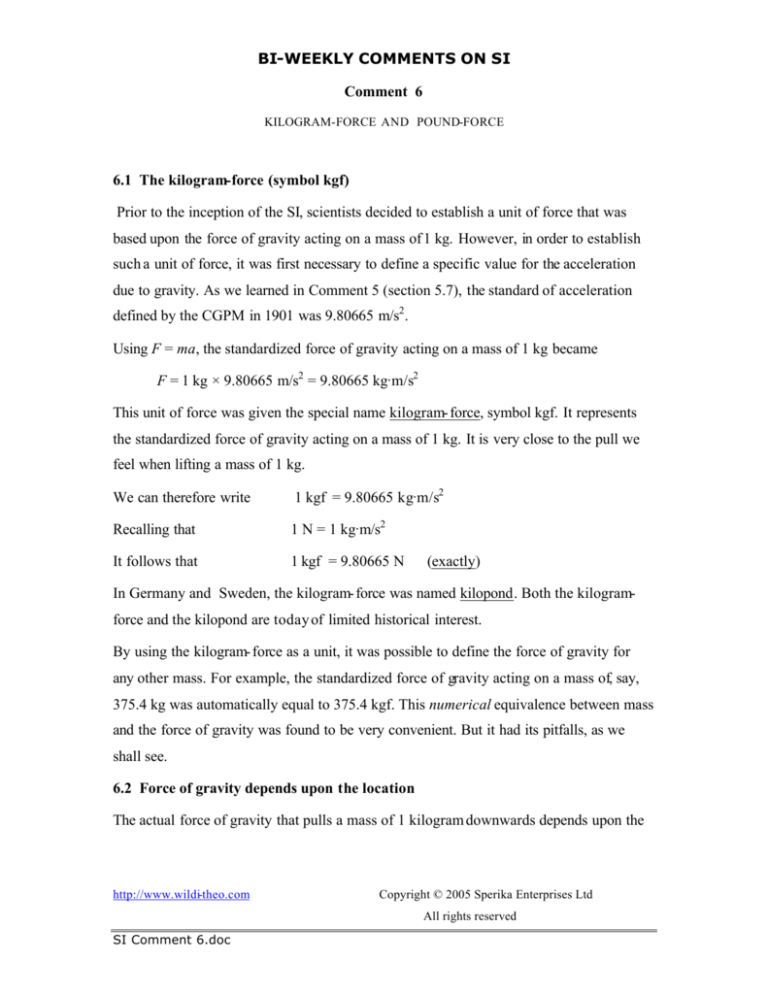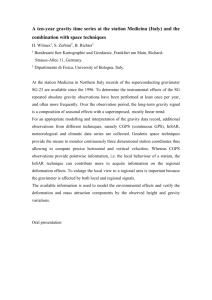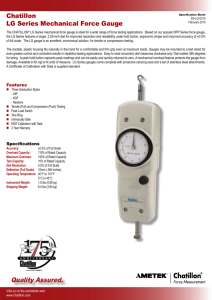
BI-WEEKLY COMMENTS ON SI
Comment 6
KILOGRAM-FORCE AND POUND-FORCE
6.1 The kilogram-force (symbol kgf)
Prior to the inception of the SI, scientists decided to establish a unit of force that was
based upon the force of gravity acting on a mass of 1 kg. However, in order to establish
such a unit of force, it was first necessary to define a specific value for the acceleration
due to gravity. As we learned in Comment 5 (section 5.7), the standard of acceleration
defined by the CGPM in 1901 was 9.80665 m/s2 .
Using F = ma, the standardized force of gravity acting on a mass of 1 kg became
F = 1 kg × 9.80665 m/s2 = 9.80665 kg·m/s2
This unit of force was given the special name kilogram- force, symbol kgf. It represents
the standardized force of gravity acting on a mass of 1 kg. It is very close to the pull we
feel when lifting a mass of 1 kg.
We can therefore write
1 kgf = 9.80665 kg·m/s2
Recalling that
1 N = 1 kg·m/s2
It follows that
1 kgf = 9.80665 N
(exactly)
In Germany and Sweden, the kilogram- force was named kilopond. Both the kilogramforce and the kilopond are today of limited historical interest.
By using the kilogram- force as a unit, it was possible to define the force of gravity for
any other mass. For example, the standardized force of gravity acting on a mass of, say,
375.4 kg was automatically equal to 375.4 kgf. This numerical equivalence between mass
and the force of gravity was found to be very convenient. But it had its pitfalls, as we
shall see.
6.2 Force of gravity depends upon the location
The actual force of gravity that pulls a mass of 1 kilogram downwards depends upon the
http://www.wildi-theo.com
Copyright © 2005 Sperika Enterprises Ltd
All rights reserved
SI Comment 6.doc
location. For example, the acceleration due to gravity at the National Institute of Science
and Technology (NIST) in Washington, D.C., is 9.800 821 m/s2 . Consequently, the
actual force of gravity acting on this 1 kg mass is:
FWashington = ma = 1 kg × 9.800 821 m/s2 = 9.800 821 kg·m/s2
However, since by definition 1 kgf = 9.80665 kg·m/s2 , it follows that
FWashington = 9.800 821/9.80665 kgf = 0.999 406 kgf
6.2 The pound-force (symbol lbf)
The unit named “pound-force” was established in a way similar to the kilogram- force.
However, the pound (lb), foot (ft), and second (s) were used as base units. Also, the
scientific authorities had established by definition that ft = 0.3048 m exactly.
Consequently, the standard acceleration due to gravity in the foot, pound, second system
became (9.80665/0.3048) ft/s2 = 32.17404... ft/s2
Again using F = ma, the standardized force of gravity (in foot, pound, second terms)
acting on a mass of 1 lb became
F = ma = 1 lb × 32.1740 ft/s2 = 32.1740 lb·ft/s2
This unit was given the special name pound-force, symbol lbf.
Therefore
1 lbf = 32.1740... lb·ft/s2
By using the pound- force as a unit, it was possible to define the force of gravity for any
other mass. For example, the standardized force of gravity acting on a mass of , say,
35.6 lb was automatically equal to 35.6 lbf. This numerical relationship between mass
and the force of gravity was found to be very convenient. But it also had its pitfalls, as we
shall see.
6.3 Confusion caused by kgf and lbf
The unit of force kgf caused much confusion, because people tended to drop the term
“force” appended to kilogram, and simply called the “kilogram- force” a “kilogram”. As a
result, mass became confused with force, and many people thought the two meant the
same thing. But, as we know, mass and force are entirely different physical quantities.
http://www.wildi-theo.com
Copyright © 2005 Sperika Enterprises Ltd
All rights reserved
SI Comment 6.doc
The same confusion occurred with the pound- force, because people again dropped the
word “force”, and simply said “pound” instead of “pound-force”. As a result, people
again got the impression that mass and force were the same thing. Holy cow! What a
mess !
Fortunately, the SI solved this vexing problem by naming the newton as the unit of force
and the kilogram as the unit of mass. All units of force based upon the force of gravity
were dropped with the advent of SI. However, the pervasive 9.80665 m/s2 lives on to this
day, as regards the calculation of the nominal force of gravity acting on a body at the
surface of the Earth.
6.4 The poundal (historical)
Referring to the Wildi SI Chart on ⊗ FORCE, the poundal is a special name for another
unit of force that was devised in earlier years. It is the force needed to accelerate a mass
of 1 lb at a rate of 1 ft/s2 . The chart shows graphically that the poundal is considerably
smaller than the newton. Today, the poundal is only of historical interest.
6.5 The dyne (historical)
An earlier metric system that used the centimeter, gram and second as base units, defined
a special unit of force, named the dyne. One dyne is the force needed to accelerate a mass
of 1 gram at a rate of 1 cm/s2 . The dyne is only of historical interest.
6.6 The words weight and weigh
The noun “weight” means force. Thus, at the surface of the Earth, a mass of
5.4 kilograms (5.4 kg) has a weight that is close to 5.4 × 9.80665 = 52.9 N.
The term “weigh” usually implies mass; for example, this box weighs 250 kilograms.
6.6 Just for fun – try this SI quiz
a) A force of 7 newtons is applied to a mass of 4 kg that is initially at rest. Calculate the
resulting acceleration in m/s2
b) Referring to the appropriate Wildi SI Chart, and assuming 4- figure accuracy, express
the following quantities in SI units:
(i) 50 ft/s2
(ii) 50 ft/s
http://www.wildi-theo.com
SI Comment 6.doc
(iii) 40 pounds
(iv) 40 pound- force
Copyright © 2005 Sperika Enterprises Ltd, All rights reserved
The solutions to these questions are given below. But don’t look until you’ve tried to
discover the answers by yourself.
⊗ SOLUTIONS
THAT’S ALL FOR NOW FOLKS !
SEE YOU IN TWO WEEKS !
This large beam balance, more than 1.3 meter high is employed for comparing heavy masses.
Two standard 500-lb masses are shown in the foreground. (Courtesy of U.S. Department of
Commerce, National Bureau of Standards)
http://www.wildi-theo.com
Copyright © 2005 Sperika Enterprises Ltd
All rights reserved
SI Comment 6.doc











